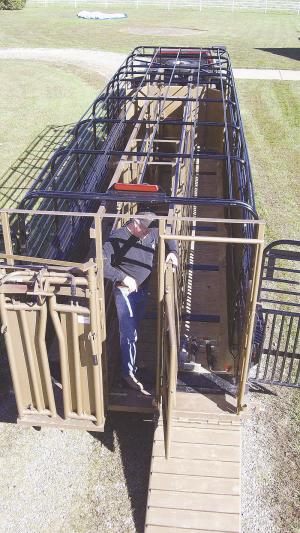2010 - Volume #34, Issue #1, Page #10
[ Sample Stories From This Issue | List of All Stories In This Issue | Print this story
| Read this issue]
Work Cattle In Trailer... Then Haul 'Em
 |
"I got hurt one too many times working cattle," says Kell. "I decided to build a permanent working alley in an old horse trailer. It's much safer."
The working trailer gets plenty of use. Kell's son runs 420 cow/calf pairs, and Kell runs another 350. After seeing the benefits, he decided to build a unit that would slide in and out of a trailer. Kell took his ideas to a local welder and eventually to Central States Mechanical of Mountain Grove, Mo. After getting the unit patented, he is now beginning to market it.
The design is a simple U shape with cattle moving down one side of the trailer to the front and then back to the rear of the trailer where a head gate is installed. The cattleman, vet and others can walk freely down the inside of the U. They are protected from kicks by solid side panels, and the cattle are visually isolated from the people and stay calmer.
The panel frames are tubular steel with 14 ga. flat steel on the outside. They are attached to a solid framework of 2 by 4-in. heavy gauge rectangular tubing. When smaller cattle or calves are worked, the working alleyway can be made narrower.
"The working alley can be quickly and easily adjusted from 25 in. down to 16 in.," says Kell. "The size of the cattle that can be worked in a trailer depends on the width of the trailer. A 6-ft. wide trailer can be set up to work animals that are 800 to 1,000 lbs. or less. A 6-ft., 8-in. trailer can handle 1,200 to 1,400 lb. cows with lots of room for workers in the walkway. We can make the alleyways for 7 to 7 1/2 ft. width trailers too and for trailer lengths of 16, 20 and 24 ft."
The 3,000-lb. units slide in and out easily after the first installation that can take 3 to 4 hours. Kell explains that holes have to be drilled in the cross members, and latches and other hardware have to be installed. Permanent tracks are welded to the floor.
"Once setup is complete, you slide the unit into the trailer, stick in bolts and turn them down," says Kell. "In five minutes you can have it in and ready to work cattle or have it out and ready to haul."
To install, jacks raise the alleyway about 2 in. above the level of the trailer floor. A driver backs the trailer up, sliding the trailer in, removing the jacks as he goes. Once in place, the unit is bolted down. To remove, the process is reversed.
"With the cattle market where it is, we have tried to keep costs down as low as we can," says Kell. "The base unit is priced at $7,400. One of our neighbors got kicked in the knee while working calves in his open trailer. He said our alleyway would have saved him $80,000 in medical costs."
Contact: FARM SHOW Followup, Double K Alleyways, LLC, P.O. Box 83, Raymondville, Mo. 65555 (ph 573 674-1225; www.doublekalleyways.com).

Click here to download page story appeared in.

Click here to read entire issue
To read the rest of this story, download this issue below or click here to register with your account number.




